Interaction of Glass Powder with Al Powder and Zinc Oxide in Aluminum Paste
Abstract
1. Introduction
2. Materials and Methods
2.1. Experimental Materials
2.2. Experimental Sample Preparation
2.3. Characterization
3. Results and Discussion
3.1. Wetting Behavior of Glass Powder Compacts on Aluminum Powder Compacts
3.2. EDS Analysis of the Cross-Section of Glass Powder Compacts and Aluminum Powder Compacts
3.3. Wetting Behavior of Glass Powder Compacts on Zinc Oxide Substrates
3.4. EDS Analysis of the Cross-Section of Glass Powder Compacts with Zinc Oxide Substrates
3.5. Influence of Glass Powder Wetting Property on the Surface Densification of Aluminum Pastes
3.6. Influence of Glass Powder Wetting Property on Adhesion
4. Conclusions
- Those glass powders having better wetting property to Al fully disperse into Al at lower temperatures and form the surface of the conductive film layer with fewer holes and high density and provides adhesion to the paste.
- Those glass powders having better wetting property to Zinc oxide form a transition layer, due to dispersion of the flow with Al at higher temperatures. Due to the diffusive growth of the Zinc oxide matrix towards the glass, better adhesion is provided.
- Those glass powders having better wetting property to Al can better prevent the excessive oxidation of Al to form defects at higher temperatures.
Author Contributions
Funding
Institutional Review Board Statement
Informed Consent Statement
Data Availability Statement
Conflicts of Interest
References
- Cao, W.; Liu, Z.H.; Chen, X.M.; Gu, S.Q.; Wan, S.; Zhu, Y.T. Development and Application of the High-Gradient Zinc Oxide Varistor. In Proceedings of the 2021 35th International Conference on Lightning Protection (ICLP) and XVI International Symposium on Lightning Protection (SIPDA), Colombo, Sri Lanka, 20–26 September 2021. [Google Scholar]
- Ma, H.; Zhu, X.; Long, J.; Cao, M. Influence of Adding Ag on Copper Electrode Paste for Zno Varistor. New Chem. Mater. 2020, 48, 85. [Google Scholar]
- Chuang, K.C.; Lee, W.-H. Improvement on Conductivity for Thick Film Aluminum Paste. J. Nanosci. Nanotechnol. 2021, 21, 4726–4734. [Google Scholar] [CrossRef]
- Ma, X.; Zhu, X.; Long, J.; Cao, M. Research Status and Development Tendency of Sintering Process for Electronic Paste. Hot Work. Technol. 2017, 46, 14–19. [Google Scholar]
- Zhang, M.; Chen, C.J.; Li, C.Y. Wetting and Sealing of the Interface between Silicate Glass and Copper. Int. J. Mater. Res. 2019, 110, 163–173. [Google Scholar] [CrossRef]
- Eustathopoulos, N. Dynamics of Wetting in Reactive Metal Ceramic Systems. Acta Mater. 1998, 46, 2319–2327. [Google Scholar]
- Alghunaim, A.; Kirdponpattara, S.; Newby, B.M.Z. Techniques for Determining Contact Angle and Wettability of Powders. Powder Technol. 2016, 287, 201–215. [Google Scholar] [CrossRef]
- Yang, W.Q.; Ye, F.X. The Thermophysical Properties and the Molten Cmas Resistance Performance of Ytterbium Tantalate. Surf. Coat. Technol. 2021, 423, 127584. [Google Scholar] [CrossRef]
- Tarnovskiy, R.; Ditts, A. Influence of Temperature and Glass Composition on Aluminum Nitride Contact Angle. IOP Conf. Ser. Mater. Sci. Eng. 2016, 156, 012041. [Google Scholar] [CrossRef]
- Reis, R.M.; Mauro, J.C.; Geisinger, K.L.; Potuzak, M.; Smedskjaer, M.M.; Guo, X.; Allan, D.C. Relationship between Viscous Dynamics and the Configurational Thermal Expansion Coefficient of Glass-Forming Liquids. J. Non-Cryst. Solids 2012, 358, 648–651. [Google Scholar] [CrossRef]
- Liu, S.; Zhu, X.; Long, J. Sintering Mechanism of Electronic Aluminum Paste and Its Effect on Electrical Conductivity of Aluminum Electrode. Mater. Sci. Semicond. Process. 2022, 139, 106352. [Google Scholar] [CrossRef]
- Chen, J.; Yan, C.; Yu, Q. Effect of Zinc Oxide on Crystallization Behavior and Physical and Chemical Performance of Smelting Slag Glass Ceramics. China’s Ceram. 2019, 55, 50–55. [Google Scholar]
- Zhang, Y.; Yunxia, Y.; Jianhua, Z.; Lihua, D.; Wei, H.U.A.; Guorong, C. Effect of Glass Frit Wetting Property on the Performances of Silicon Solar Cells. J. Chin. Silic. Soc. 2008, 36, 1022–1026. [Google Scholar]
- Qu, Y.; Shang, R.; Zhou, Z.; Cheng, X.; Meng, Q.; Wang, X. Effect of Sintering Temperature on Structure and Property of Copper Composite Paste. J. Mater. Sci. Eng. 2017, 35, 671. [Google Scholar]
- Sun, Y.H.; Xue, H.B.; Yang, C.Q.; Tian, Y.X.; Ning, S.Y.; Ma, S.H.; Wang, H. Improvement of Wettability of Te-Modified Lead-Free Glass Frit and Its Effect to Front Side Silver Paste in Crystalline Silicon Solar Cells. Sol. Energy Mater. Sol. Cells 2023, 253, 112214. [Google Scholar] [CrossRef]
- Meng, Q.; Qu, Y.; Cheng, X.; Liu, X.; Zhou, Z.; Cui, H. The Effects of the Lead-Free Glass Powders on Performances of Copper Electronic Paste. J. Funct. Mater. 2016, 47, 2130. [Google Scholar]
- Tang, J.Y.; Mak, C.H.H.; Tam, S.K.; Ng, K.M. Formulation of a Paste for Copper Thick Film. J. Nanopart. Res. 2021, 23, 166. [Google Scholar] [CrossRef]
- Rane, S.B.; Seth, T.; Phatak, G.J.; Amalnerkar, D.P.; Ghatpande, M. Effect of Inorganic Binders on the Properties of Silver Thick Films. J. Mater. Sci. Mater. Electron. 2004, 15, 103–106. [Google Scholar] [CrossRef]
- Gan, W.; Yue, Y.; Luo, L.; Pan, Q.; Xiong, Z. Preparation of Lead-Free Conductive Silver Paste and Its Sintering Technology. Paint. Coat. Ind. 2014, 44, 31. [Google Scholar]
- Zhu, W.; Liu, J.; Dong, Y.; Wei, M.; Tang, W. Sinter Blistering and Its Elimination Method in the Au/Resistance Composite Thick Film on the Ceramic Substrate. Electron. Compon. Mater. 2019, 38, 54–61. [Google Scholar]
- Gan, W.; Luo, L.; Xiong, Z.; Xiang, F.; Yue, Y. Influence of Softening Temperature of Glass Powder on Crystalline Silicon Solar Cell Performance. Mater. Rev. 2013, 27, 12–16. [Google Scholar]
- Chen, J.; Yang, D.A.; Zhai, T.; Gui, B.Q.; Wang, Q. Influence of B2O3–SiO2–ZnO–BaO Glass Ratio and Sintering Temperature on the Microstructure and Property of Copper Thick Film for Low Temperature Co-Fired Ceramic. J. Mater. Sci.-Mater. Electron. 2016, 27, 1929–1937. [Google Scholar] [CrossRef]


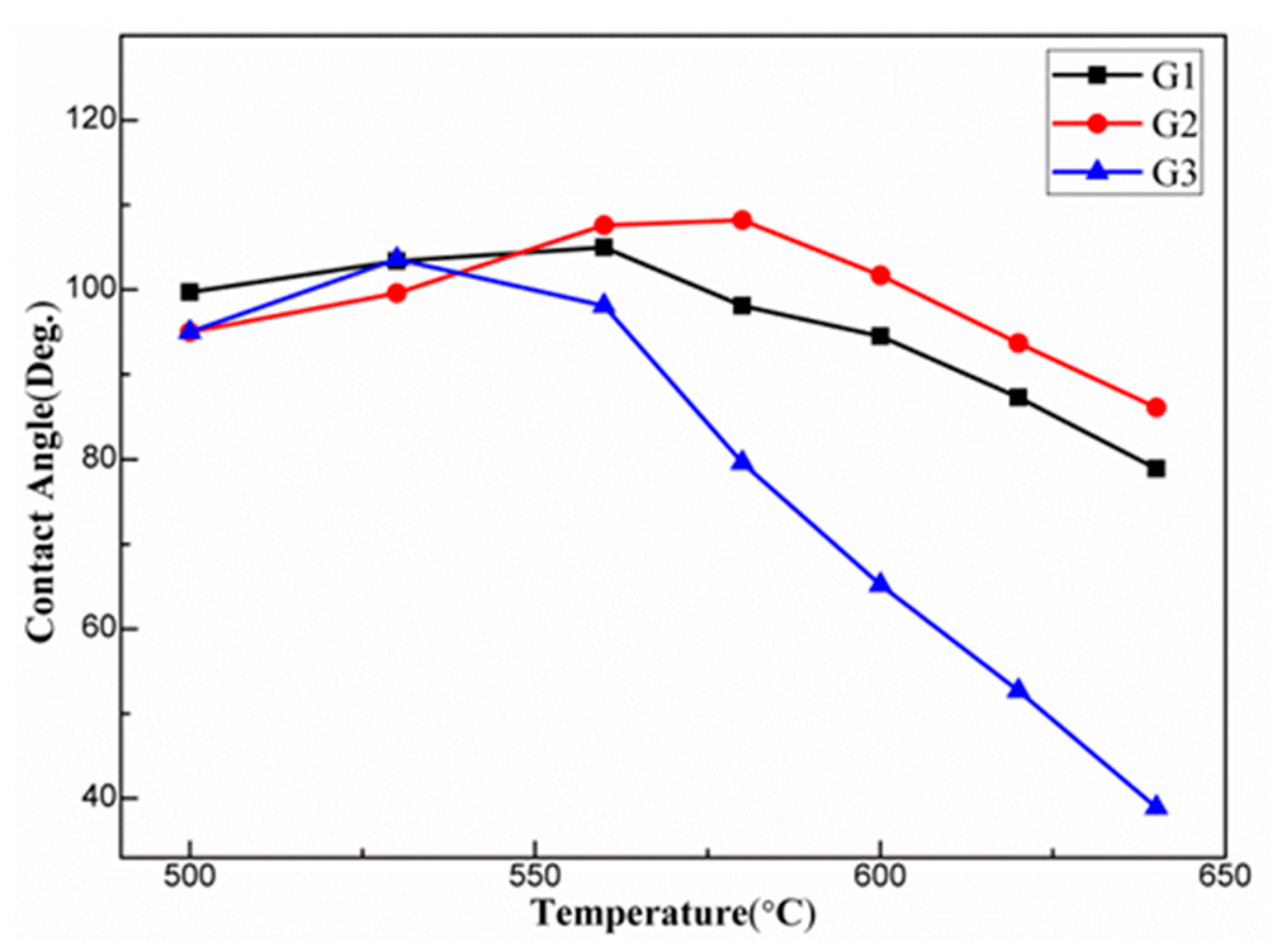
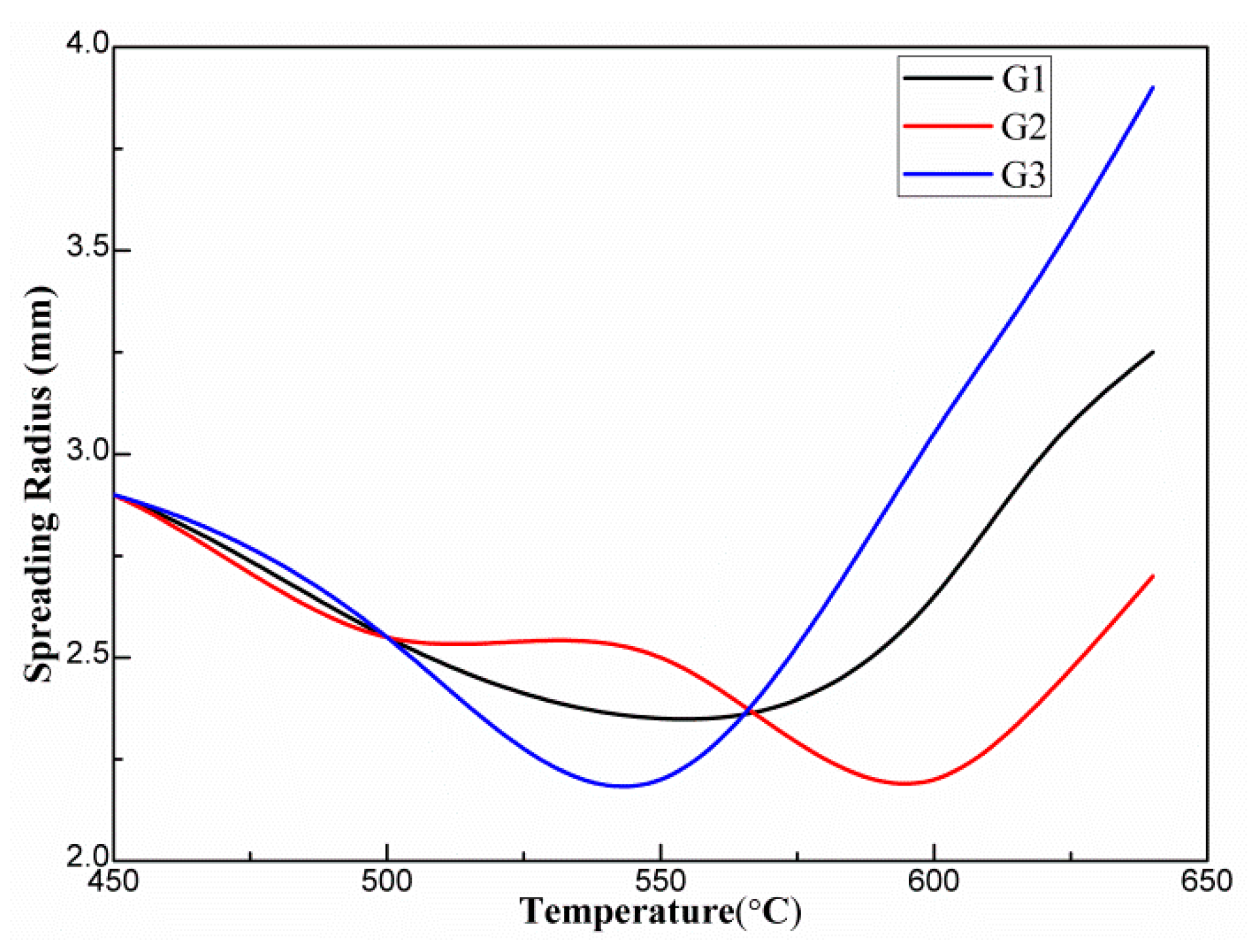

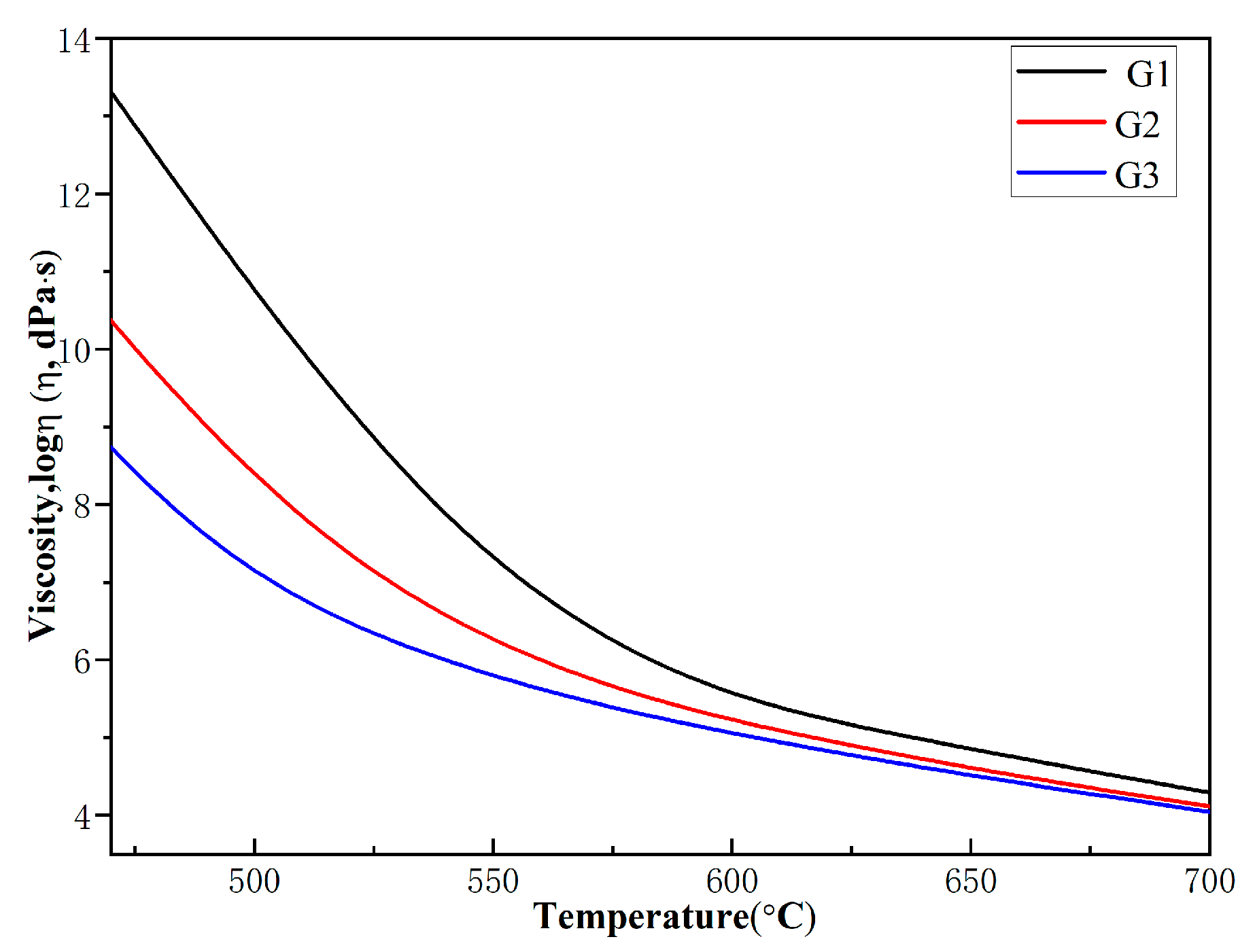


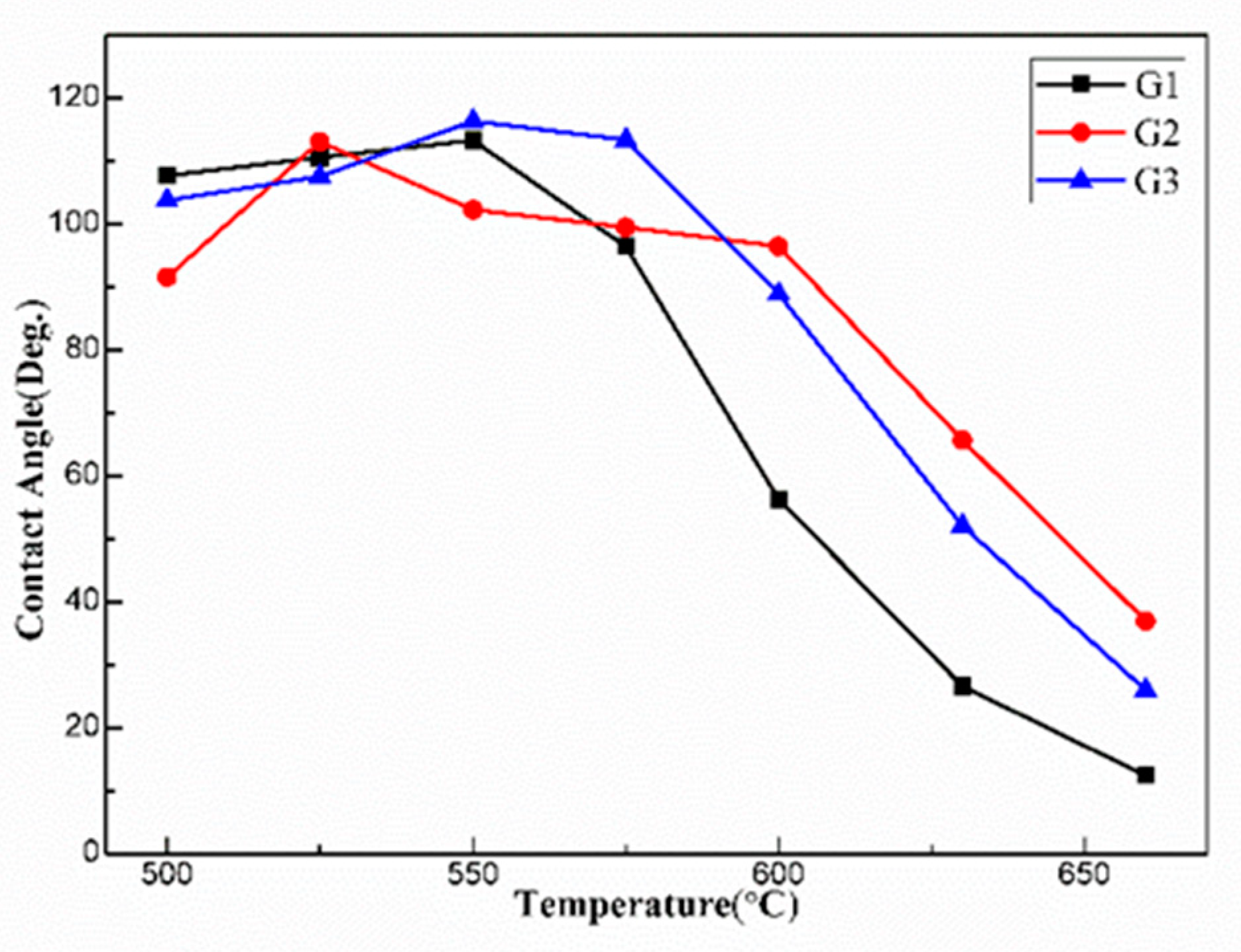



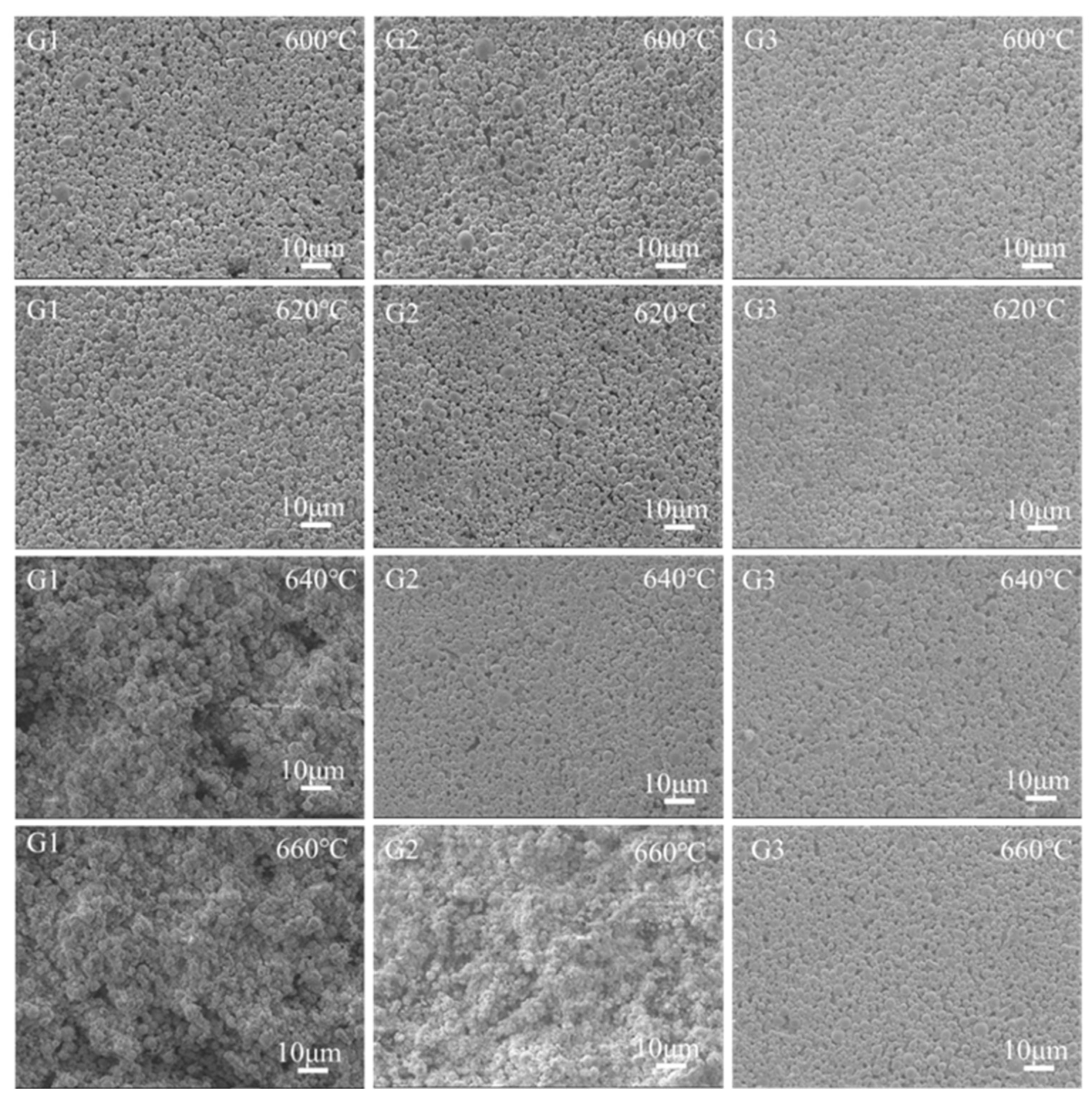

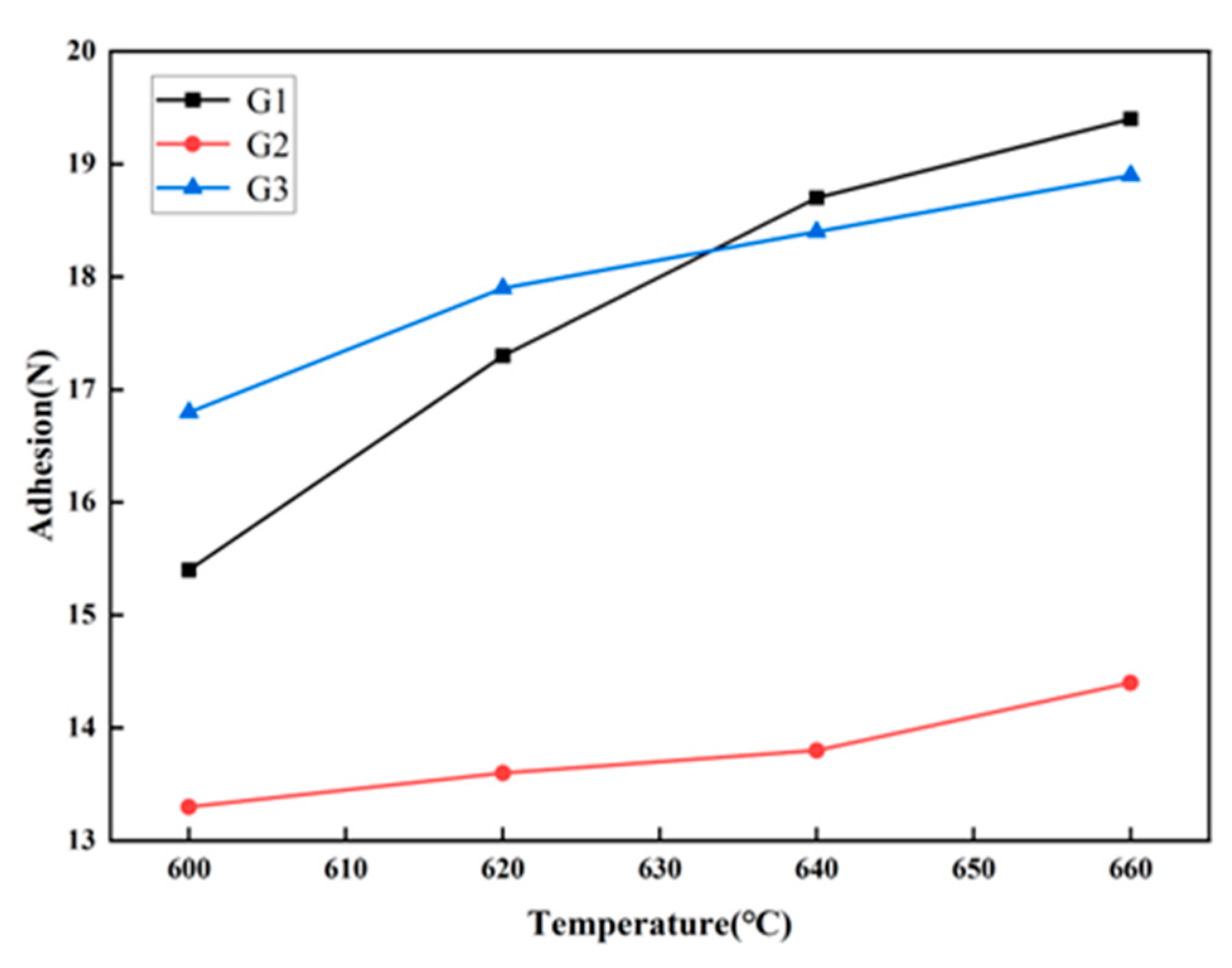
| Bi2O3 | B2O3 | SiO2 | ZnO | Others | Total | Tg (°C) | |
|---|---|---|---|---|---|---|---|
| G1 | 70 | 15 | 6 | 0 | 9 | 100 | 449 |
| G2 | 70 | 15 | 1 | 12 | 2 | 100 | 434 |
| G3 | 70 | 15 | 3 | 6 | 6 | 100 | 464 |
| Point | O | Al | Si | Zn | Bi | Sb |
|---|---|---|---|---|---|---|
| 1 | 79.73 | 3.78 | 3.04 | — | 13.44 | — |
| 2 | 7.92 | 60.62 | 8.91 | — | 22.55 | — |
| 3 | 38.08 | 61.38 | 0.29 | — | 0.25 | — |
| 4 | 77.21 | 2.32 | 6.33 | 6.75 | 7.38 | — |
| 5 | 61.46 | 13.01 | 7.81 | 8.28 | 9.43 | — |
| 6 | 23.57 | 76.43 | — | — | — | — |
| 7 | 76.34 | 2.26 | 6.62 | 5.39 | 7.58 | 1.82 |
| 8 | 55.62 | 14.67 | 3.22 | 3.24 | 21.84 | 1.41 |
| 9 | 31.72 | 68.16 | 0.12 | — | — | — |
| Point | O | Si | Zn | Bi | B | Sb |
|---|---|---|---|---|---|---|
| 1 | 76.67 | 4.48 | — | 15.56 | 3.29 | — |
| 2 | 60.26 | — | 34.34 | — | 5.40 | — |
| 3 | 48.15 | — | 51.85 | — | — | — |
| 4 | 69.91 | 1.97 | — | 21.75 | 6.37 | — |
| 5 | 60.22 | 0.28 | 38.41 | 0.40 | 0.69 | — |
| 6 | 47.25 | — | 52.75 | — | — | — |
| 7 | 75.87 | 3.09 | — | 14.23 | 5.71 | 1.10 |
| 8 | 63.88 | — | 36.12 | — | — | — |
| 9 | 49.76 | — | 50.24 | — | — | — |
| 10 | 59.22 | 2.56 | — | 17.74 | 5.45 | 15.03 |
Disclaimer/Publisher’s Note: The statements, opinions and data contained in all publications are solely those of the individual author(s) and contributor(s) and not of MDPI and/or the editor(s). MDPI and/or the editor(s) disclaim responsibility for any injury to people or property resulting from any ideas, methods, instructions or products referred to in the content. |
© 2024 by the authors. Licensee MDPI, Basel, Switzerland. This article is an open access article distributed under the terms and conditions of the Creative Commons Attribution (CC BY) license (https://creativecommons.org/licenses/by/4.0/).
Share and Cite
Hou, L.; Liu, S.; Zhu, X. Interaction of Glass Powder with Al Powder and Zinc Oxide in Aluminum Paste. Coatings 2024, 14, 64. https://doi.org/10.3390/coatings14010064
Hou L, Liu S, Zhu X. Interaction of Glass Powder with Al Powder and Zinc Oxide in Aluminum Paste. Coatings. 2024; 14(1):64. https://doi.org/10.3390/coatings14010064
Chicago/Turabian StyleHou, Lizhi, Shunke Liu, and Xiaoyun Zhu. 2024. "Interaction of Glass Powder with Al Powder and Zinc Oxide in Aluminum Paste" Coatings 14, no. 1: 64. https://doi.org/10.3390/coatings14010064
APA StyleHou, L., Liu, S., & Zhu, X. (2024). Interaction of Glass Powder with Al Powder and Zinc Oxide in Aluminum Paste. Coatings, 14(1), 64. https://doi.org/10.3390/coatings14010064





